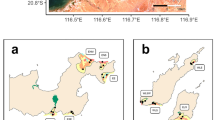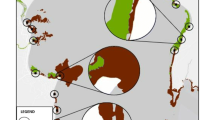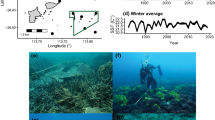Abstract
Context
In heterogeneous landscapes, local patterns of community structure are a product of the habitat size and condition within a patch interacting with adjacent habitat patches of varying composition and quantity. While evidence for local versus landscape factors have been found in terrestrial biomes, support for such multi-scale effects shaping marine ecological communities is equivocal.
Objectives
We investigated whether within-patch habitat condition can override seascape context to explain the community structure of macroalgae-associated reef fishes across a tropical seascape.
Methods
We mapped the distribution and abundance of a diverse family of reef fishes (Labridae) occupying macroalgae meadows within a tropical reef ecosystem, and using best-subsets model selection, investigated the potential for habitat structural connectivity and/or local habitat quality for predicting variations in fish community structure across the seascape.
Results
Local habitat quality (canopy structure, hard habitat complexity) and area of coral-dominated habitat within 500 m of a macroalgal meadow provided the best predictors of fish community structure. However, the specific importance of a given predictor varied with fish life history stage and functional trophic group. Interestingly, macroalgae meadow area was among the least important predictors.
Conclusions
Given the complex interplay between local habitat quality and spatial context effects on fish biodiversity, our study reveals the multi-scale predictors that should be used in spatial conservation and management approaches for tropical fish diversity. Moreover, our findings question the ubiquity of habitat area effects in patchy landscapes, and cautions against a sole reliance on habitat quantity in spatial management.






Similar content being viewed by others
References
Acosta CA, Robertson DN (2002) Diversity in coral reef fish communities: the effects of habitat patchiness revealed. Mar Ecol Prog Ser 227:87–96
Anderson MJ, Ellingsen KE, McArdle BH (2006) Multivariate dispersion as a measure of beta diversity. Ecol Lett 9:683–693
Anderson MJ, Gorley RN, Clarke KR (2008) PERMANOVA+ for PRIMER: guide to software and statistical methods
Berkström C, Gullström M, Lindborg R, Mwandya AW, Yahya SAS, Kautsky N, Nyström M (2012) Exploring “knowns” and “unknowns” in tropical seascape connectivity with insights from East African coral reefs. Estuar Coast Shelf Sci 107:1–21
Berkström C, Lindborg R, Thyresson M, Gullström M (2013) Assessing connectivity in a tropical embayment: fish migrations and seascape ecology. Biol Conserv 166:43–53
Boström C, Pittman SJ, Simenstad C, Kneib RT (2011) Seascape ecology of coastal biogenic habitats: advances, gaps, and challenges. Mar Ecol Prog Ser 427:191–217
Brown CJ, Harborne AR, Paris CB, Mumby PJ (2016) Uniting paradigms of connectivity in marine ecology. Ecology 97:2447–2457
Burnham KP, Anderson MJ (2002) Model selection and multi-model inference: a practical information-theoretic approach, 2nd edn. Springer, New York
Calabrese JM, Fagan WF (2004) A comparison-shopper’s guide to connectivity metrics. Front Ecol Environ 2:529–536
Chaves LTC, Pereira PHC, Feitosa JLL (2013) Coral reef fish association with macroalgal beds on a tropical reef system in North-eastern Brazil. Mar Freshw Res 64:1101–1111
Cheminée A, Merigot B, Vanderklift MA, Francour P (2016) Does habitat complexity influence fish recruitment? Mediterr Mar Sci 17:39–46
Chittaro P (2002) Species-area relationships for coral reef fish assemblages of St. Croix, US Virgin Islands. Mar Ecol Prog Ser 233:253–261
Cuadros A, Cheminée A, Thiriet P, Moranta J, Vidal E, Sintes J, Sagristá Cardona L (2017) The three-dimensional structure of Cymodocea nodosa meadows shapes juvenile fish assemblages at Fornells Bay (Minorca Island). Reg Stud Mar Sci 14:93–101
Darling ES, Graham NAJ, Januchowski-Hartley FA, Nash KL, Pratchett MS, Wilson SK (2017) Relationships between structural complexity, coral traits, and reef fish assemblages. Coral Reefs 36:561–575
Davis JP, Pitt KA, Fry B, Olds AS, Connolly RM (2014) Seascape-scale trophic links for fish on inshore coral reefs. Coral Reefs 33:897–907
Eggertsen L, Ferreira CEL, Fontoura L, Kautsky N, Gullström M, Berkström C (2017) Seaweed beds support more juvenile reef fish than seagrass beds: carrying capacity in a south-western Atlantic tropical seascape. Estuar Coast Shelf Sci. https://doi.org/10.1016/j.ecss.2017.06.041
Evans RD, Wilson SK, Field SN, Moore JAY (2014) Importance of macroalgal fields as coral reef fish nursery habitat in north-west Australia. Mar Biol 161:599–607
Fahrig L (2013) Rethinking patch size and isolation effects: the habitat amount hypothesis. J Biogeogr 40:1649–1663
Fulton CJ, Bellwood DR (2002) Patterns of foraging in labrid fishes. Mar Ecol Prog Ser 226:135–142
Fulton CJ, Depczynski M, Holmes TH, Noble MM, Radford B, Wernberg T, Wilson SK (2014) Sea temperature shapes seasonal fluctuations in seaweed biomass within the Ningaloo coral reef ecosystem. Limnol Oceanogr 59:156–166
Fulton CJ, Wainwright PC, Hoey AS, Bellwood DR (2017) Global ecological success of Thalassoma fishes in extreme coral reef habitats. Ecol Evol 7:466–472
Garden JG, McAlpine CA, Possingham HP (2010) Multi-scaled habitat considerations for conserving urban biodiversity: native reptiles and small mammals in Brisbane, Australia. Landsc Ecol 25:1013–1028
Green AL, Maypa AP, Almany GR, Rhodes KL, Weeks R, Abesamis RA, Gleason MG, Mumby PJ, White AT (2015) Larval dispersal and movement patterns of coral reef fishes, and implications for marine reserve network design. Biol Rev 90:1215–1247
Grober-Dunsmore R, Frazer TK, Lindberg WJ, Beets J (2007) Reef fish and habitat relationships in a Caribbean seascape: the importance of reef context. Coral Reefs 26:201–216
Haddad NM, Gonzalez A, Brudvig LA, Burt MA, Levey DJ, Damschen EI (2017) Experimental evidence does not support the Habitat Amount Hypothesis. Ecography (Cop) 40:48–55
Hanski I, Schulz T, Wong SC, Ahola V, Ruokolainen A, Ojanen SP (2017) Ecological and genetic basis of metapopulation persistence of the Glanville fritillary butterfly in fragmented landscapes. Nat Commun 8:14504
Hardin G (1960) The competitive exclusion principle. Science 131:1292–1297
Henderson CJ, Gilby BL, Lee SY, Stevens T (2017) Contrasting effects of habitat complexity and connectivity on biodiversity in seagrass meadows. Mar Biol 164:117
Hixon MA (2015) Predation: piscivory and the ecology of coral-reef fishes. In: Mora C (ed) Ecology of Fishes on Coral Reefs. Cambridge University Press, Cambridge, pp 41–53
Hortal J, Triantis KA, Meiri S, Thébault E, Sfenthourakis S (2009) Island species richness increases with habitat diversity. Am Nat 174:E205–E217
Kendall MS, Miller TJ, Pittman SJ (2011) Patterns of scale-dependency and the influence of map resolution on the seascape ecology of reef fish. Mar Ecol Prog Ser 427:259–274
Kobryn HT, Wouters K, Beckley LE, Heege T (2013) Ningaloo reef: shallow marine habitats mapped using a hyperspectral sensor. PLoS ONE. https://doi.org/10.1371/journal.pone.0070105
Kramer MJ, Bellwood O, Fulton CJ, Bellwood DR (2015) Refining the invertivore: diversity and specialisation in fish predation on coral reef crustaceans. Mar Biol 162:1779–1786
Kulbicki M, Guillemot N, Amanda M (2005) A general approach to length-weight relationships for New Caledonian lagoon fishes. Cybium 29:235–252
Levin PS, Hay ME (1996) Responses of temperate reef fishes to alterations in algal structure and species composition. Mar Ecol Prog Ser 134:37–47
Lim IE, Wilson SK, Holmes TH, Noble MM, Fulton CJ (2016) Specialization within a shifting habitat mosaic underpins the seasonal abundance of a tropical fish. Ecosphere 7:1–13
MacArthur RH, Wilson EO (1963) An equilibrium theory of insular zoogeography. Evolution (N Y) 17:1247–1262
Malcolm HA, Smith SDA (2010) Objective selection of surrogate families to describe reef fish assemblages in a subtropical marine park. Biodivers Conserv 19:3611–3618
McIlwain JL (2003) Fine-scale temporal and spatial patterns of larval supply to a fringing reef in Western Australia. Mar Ecol Prog Ser 252:207–222
Melo GL, Sponchiado J, Cáceres NC, Fahrig L (2017) Testing the habitat amount hypothesis for South American small mammals. Biol Conserv 209:304–314
Michael DR, Ikin K, Crane M, Okada S, Lindenmayer DB (2017) Scale-dependent occupancy patterns in reptiles across topographically different landscapes. Ecography (Cop) 40:415–424
Nash KL, Welsh JQ, Graham NAJ, Bellwood DR (2015) Home-range allometry in coral reef fishes: comparison to other vertebrates, methodological issues and management implications. Oecologia 177:73–83
Noble MM, van Laake G, Berumen ML, Fulton CJ (2013) Community change within a caribbean coral reef marine protected area following two decades of Local management. PLoS ONE 8:25–27
Olds AD, Connolly RM, Pitt KA, Maxwell PS (2012) Primacy of seascape connectivity effects in structuring coral reef fish assemblages. Mar Ecol Prog Ser 462:191–203
Pittman SJ, Caldow C, Hile SD, Monaco ME (2007) Using seascape types to explain the spatial patterns of fish in the mangroves of SW Puerto Rico. Mar Ecol Prog Ser 348:273–284
Pittman SJ, Olds AD (2015) Seascape Ecology of fishes on coral reefs. In: Mora C (ed) Ecology of fishes on coral reefs. Cambridge University Press, Cambridge, pp 274–282
Polunin NVC, Roberts CM (1993) Greater biomass and value of target coral-reef fishes in two small Caribbean marine reserves. Mar Ecol Prog Ser 100:167–176
Pratchett MS, Hoey AS, Wilson SK, Messmer V, Graham NAJ (2011) Changes in biodiversity and functioning of reef fish assemblages following coral bleaching and coral loss. Diversity 3:424–452
Rabelo RM, Bicca-Marques JC, Aragón S, Nelson BW (2017) Are fluvial islands “real” islands for arboreal mammals? Uncovering the effect of patch size under the species-area relationship. J Biogeogr 44:1–11
Shanahan DF, Miller C, Possingham HP, Fuller RA (2011) The influence of patch area and connectivity on avian communities in urban revegetation. Biol Conserv 144:722–729
Simberloff D, Wilson E (1970) Experimental zoogeography of islands. A two-year record of colonization. Ecology 51:267–278
Staveley TAB, Perry D, Lindborg R, Gullström M (2016) Seascape structure and complexity influence temperate seagrass fish assemblage composition. Ecography (Cop) 40:1–11
Tano S, Eggertsen M, Wikstrom SA, Berkström C, Buriyo AS, Halling C (2016) Tropical seaweed beds are important habitats for mobile invertebrate epifauna. Estuar Coast Shelf Sci 183:1–12
Tano SA, Eggertsen M, Wikström SA, Berkström C, Buriyo AS, Halling C (2017) Tropical seaweed beds as important habitats for juvenile fish. Mar Freshw Res 68:1921
Turner MG (1989) Landscape ecology: the Effect of pattern on process. Annu Rev Ecol Syst 20:171–197
Turner MG (2005) What Is the State of the Science? Annu Rev Ecol Evol Syst 36:319–344
Tuya F, Wernberg T, Thomsen MS (2009) Habitat structure affect abundances of labrid fishes across temperate reefs in south-western Australia. Environ Biol Fishes 86:311–319
van Lier JR, Harasti D, Laird R, Noble MM, Fulton CJ (2017) Importance of soft canopy structure for labrid fish communities in estuarine mesohabitats. Mar Biol 164:45
Vergés A, Vanderklift MA, Doropoulos C, Hyndes GA (2011) Spatial patterns in herbivory on a coral reef are influenced by structural complexity but not by algal traits. PLoS ONE. https://doi.org/10.1371/journal.pone.0017115
Wenger L, van Lier J, Fulton C (2018) Microhabitat selectivity shapes the seascape ecology of a carnivorous macroalgae-associated tropical fish. Mar Ecol Prog Ser 590:187–200
Wilson SK, Depczynski M, Fisher R, Holmes TH, O’Leary RA, Tinkler P (2010) Habitat associations of juvenile fish at Ningaloo Reef, Western Australia: the importance of coral and algae. PLoS ONE 5:1–8
Wilson SK, Depczynski M, Holmes TH, Noble MM, Radford BT, Tinkler P, Fulton CJ (2017) Climatic conditions and nursery habitat quality provide indicators of reef fish recruitment strength. Limnol Oceanogr 62:1868–1880
Wilson SK, Fulton CJ, Depczynski M, Holmes TH, Noble MM, Radford B, Tinkler P (2014) Seasonal changes in habitat structure underpin shifts in macroalgae-associated tropical fish communities. Mar Biol 161:2597–2607
Acknowledgements
This research is supported by an Australian Government Research Training Program (RTP) Scholarship, as well as with funding provided by the Linnean Society of New South Wales. We also wish to thank Kelsey Sanborn for assistance in the field.
Author information
Authors and Affiliations
Corresponding author
Ethics declarations
Conflict of interest
All authors declare they have no conflict of interest.
Ethical approval
This work was conducted with the approval of the ANU Animal Ethics Committee (protocol A2016/03).
Electronic supplementary material
Below is the link to the electronic supplementary material.
Rights and permissions
About this article
Cite this article
van Lier, J.R., Wilson, S.K., Depczynski, M. et al. Habitat connectivity and complexity underpin fish community structure across a seascape of tropical macroalgae meadows. Landscape Ecol 33, 1287–1300 (2018). https://doi.org/10.1007/s10980-018-0682-4
Received:
Accepted:
Published:
Issue Date:
DOI: https://doi.org/10.1007/s10980-018-0682-4




